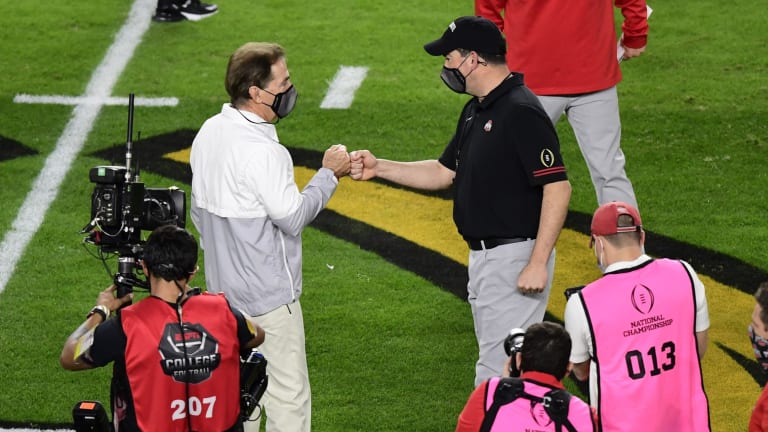
Unity the Key to Leveling College Football's Tilted Field

You may have noticed that I am not unveiling my Sweet 16 one day at a time this pre-season.
As I told Blaudschun, the college-football world doesn’t need me to tell it that Alabama, Georgia, Clemson, Oklahoma and Ohio State are the pre-season top five.
I list those five in no particular order. Or perhaps in order of their distance from Tuscaloosa, with the Sooners moving closer than the Buckeyes because they soon will be marching with the Sankey legion.
This is what I find sad and troubling about college football these days. It is becoming a caste society of Haves and Have Nots. And it’s very difficult to move from one of those worlds to the other.
We can hope against hope that Cincinnati or Iowa State—or North Carolina or Indiana, for those who dream really big—will save us from yet another Alabama-Clemson-Ohio State championship.
But seriously. . . give me those three and you can have the rest of the field.
In the seven years of the College Football Playoff, that Axis of Power has won six championships.
The outlier was. . . LSU. And if you think the Tigers were a big step toward parity, bang your silver spoon while I cut the crusts off your finger sandwiches.
And in the final eight years of the much-hated BCS, the SEC won seven national championships. All by itself. And now it will add Oklahoma and Texas? And a television contract to end all television contracts?
While I don’t always root for David, I don’t understand why people think it’s a good idea for people to root for Goliath to buy even sturdier Kevlar uniforms while David scrounges for shekels to replace his aging slingshot.
If the NFL allowed this kind of thing, the L.A. Rams, Dallas Cowboys, New York Giants and Chicago Bears would cut their own network TV deal—right after the team that won the Super Bowl drafted first overall.
I know. While parity has been the path to financial as well competitive success in the NFL, populism is never going to fly in the relentlessly greedy me-first world of college football.
The problem is, college football is perfectly positioned for this: A highly tilted playing field where only a handful of schools have a chance to compete at the highest level.
This isn’t merely about Oklahoma and Texas saddling up with the SEC for the staggering paycheck. By dangling the chance to play in the conference where ``It just means more,’’ they will get a giant leg up on recruiting. If the championship deck is stacked in one league, what stud recruit won't want to be dealt in there?
In the next 10 years, how many national championships will the SEC win? If the Over/Under is 8-1/2, take the Over. And if the odds are right, the 10-for-10 prop bet is worth considering. Throw in Clemson and Ohio State and it’s a dead-solid lock.
If you think a 12-team playoff will change that, think again. It will merely give a few pretenders a chance to get clobbered early—with Notre Dame getting a guaranteed home game in return for signing off on the deal.
If Teddy Roosevelt, who famously saved college football in the early 1900s by mandating that it stop killing and maiming players, were around, he would put on his trust-busting hat and halt the monopolistic practices.
But since Mark Emmert is no Teddy Roosevelt, that’s not going to happen.
So. . . what to do?
Let’s get on with it.
With Texas and Oklahoma bolting for the SEC—thus ensuring that the Big 12 will no longer be a power in the Power 5—college football has not merely advanced the rich-get-richer model.
It has taken a giant step closer to where we expect this is heading. A super-conference—some would add adjectives not suitable for gentle readers—of schools that want to play football at the highest, most committed level.
I would advise the power schools that want to play in this high-stakes poker game to contact Mr. Greg Sankey, Commissioner, Southeastern Conference, 2201 Richard Arrington Jr Blvd N, Birmingham, AL 35203.
I believe Ohio State, Notre Dame, Penn State, Florida State, Miami, USC, UCLA, Michigan, Wisconsin, Iowa, Oklahoma State, Iowa State, Baylor, Virginia Tech, Washington, Oregon, Cincinnati, UCF, Memphis, SMU and many others ought to apply discretely.
Sankey has shown he can keep a secret—and draw up effective power plays.
Let him pick the 48 or 64 (or more?) schools that will play for all the marbles—after starting out with a similar number of marbles. Call it the Southeastern Conference, with Midwestern, Atlantic, Pacific and Deep South divisions.
The NCAA will not be a player in this game. It has not been a player, if you think about it, in the most important college-football decisions for a long time. This is by design. The member schools like having a weak NCAA.
Enough with the War of Southern Aggression already
Let’s just get on with it and see who wants a seat at the high-stakes college-football poker table.